
Minsk Region, also known as Minsk Oblast or Minsk Voblasts, is one of the six regions of Belarus. Its administrative center is Minsk, although it is a separate administrative territorial entity of Belarus. The region's population was recorded at 1,411,500 in 2011.
Hero City is a Soviet honorary title awarded for outstanding heroism during World War II. It was awarded to twelve cities of the Soviet Union, today located in Belarus, Russia, and Ukraine. Brest Fortress in Belarus was awarded the equivalent title of Hero Fortress. This symbolic distinction for a city corresponds to the individual distinction "Hero of the Soviet Union".

Kurapaty is a wooded area on the outskirts of Minsk, Belarus, where a vast number of people were executed between 1937 and 1941 during the Great Purge by the Soviet secret police, the NKVD.

Pyotr Mironovich Masherov was a Soviet partisan, statesman, and one of the leaders of the Belarusian resistance during World War II who governed the Byelorussian Soviet Socialist Republic as First Secretary of the Communist Party of Byelorussia from 1965 until his death in 1980. Under Masherov's rule, Belarus was transformed from an agrarian, undeveloped nation which had not yet recovered from the Second World War into an industrial powerhouse; Minsk, the capital and largest city of Belarus, became one of the fastest-growing cities on the planet. Masherov ruled until his sudden death in 1980, after his vehicle was hit by a potato truck.

The Tomb of the Unknown Soldier is a war memorial dedicated to the Soviet soldiers killed during World War II. It was designed by architects D. I. Burdin, V. A. Klimov, Yu. R. Rabayev and sculptor Nikolai Tomsky.

Poklonnaya Gora is, at 171.5 m, one of the highest natural spots in Moscow. Its two summits were separated by the Setun River until one of the summits was razed in 1987. Since 1936, the area has been part of Moscow, and it now contains the Victory Park, with many tanks and other vehicles that were used during World War II on display.

The 2008 Minsk bombing took place just after midnight on 4 July 2008, in Minsk, Belarus and wounded 54 people. The explosion happened near the Hero City monument at a concert to celebrate Belarus' independence. The concert had been attended by Belarus' President, Alexander Lukashenko, who was not hurt and whose officials said was not the target.

The National Art Museum of the Republic of Belarus is the largest art museum in Belarus and is located in its capital, Minsk. The museum comprises more than thirty thousands works of art which make up twenty various collections and constitutes two main ones: the one of national art and the other of art monuments of various countries of the world.

Victory Square is a square in Minsk, Belarus, located at the crossing of Independence Avenue and Zakharau Street. The square is located in the historic centre of Minsk with the Museum of the 1st Congress of RSDLP, the main offices of National State TV and Radio and the City House of Marriages nearby. A green park stretches from Victory Square to the Svislach River and to the entrance to Gorky Park. Victory Square is the key landmark of Minsk, and holiday parades go through the square, while newlyweds traditionally take their picture at the square.
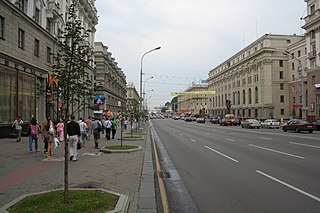
Independence Avenue is the main street of Minsk, the capital of Belarus. Independence Avenue crosses Minsk radially from its centre towards the northeast. Length of the avenue is about 15 kilometres (9.3 mi).
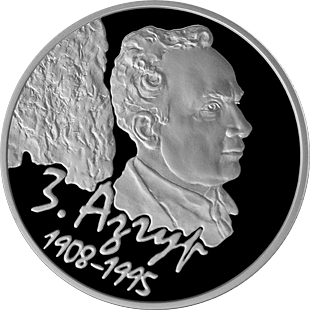
Zair Isaakovich Azgur was a Soviet and Belarusian sculptor active during the Soviet period. Born in Mogilev Governorate, he studied in that city from 1922 to 1925; from 1925 until 1928 he studied at the Vkhutein in Leningrad. He first exhibited in 1923. He was mainly active in Minsk, where among his projects was the creation of reliefs for the opera house. He created a series of portrait busts of war heroes and military figures during the 1940s. At the 1958 World's Fair in Brussels he won a silver medal for his statue of Rabindranath Tagore. Monuments to his design were erected at Luhansk in 1947; Minsk in 1947; Borodino in 1949; Suzdal in 1950; and Leninogorsk - a monument to Vladimir Lenin - in 1957. Later in his career he exhibited in Bucharest and Paris.

The Obelisk of Glory is a monument in Tolyatti's Liberty Square to the heroes of World War II.
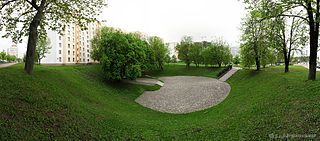
The Pit is a monument dedicated to the victims of the Holocaust on the corner of Melnikayte and Zaslavskaya streets in Minsk, Belarus. The memorial is located at the site where on 2 March 1942 Nazi forces shot about 5,000 Jewish residents of the nearby Minsk Ghetto.

Minsk Radioengineering College is an educational Institution of the Republic of Belarus. Training with secondary special education on the basis of basic education.
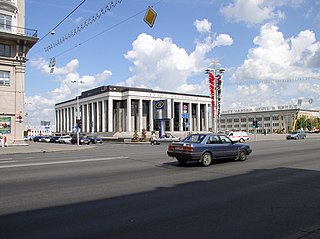
October Square is a square in the center of Minsk, Belarus, which is located between Independence Avenue, Engels streets and International Street. To its east side there are areas limited to buildings of the Palace of Culture of Trade Unions, the Museum of the Great Patriotic War and the Minsk Palace of Republic. Around the Square is the Central House of Officers, the residence of the President of Belarus, and the Janka Kupała National Academic Theater. On the square there are the main metro stations in Minsk: Kastryčnickaja and Kupawaŭskaja.
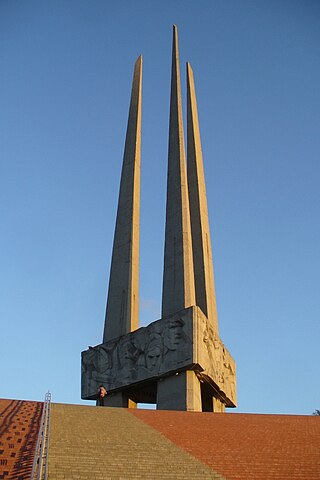
Victory Square is a square in Vitebsk, Belarus. It is currently the largest square in Belarus. It is situated on the bank of the Dvina River. During all the major public holidays, parades and performances take place on the square. In the winter, the main Christmas tree in the country is located on the square.
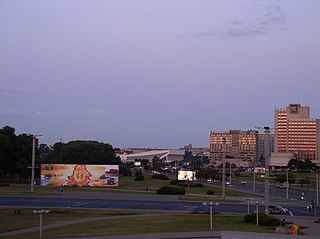
Victors Avenue is a public avenue in Minsk, Belarus.

Tatyana Savelyevna Marinenko was a Soviet partisan and intelligence officer of the NKVD during the Second World War. After she was captured and tortured by the Germans in 1942 she was posthumously declared a Hero of the Soviet Union on 8 May 1965.

The Tomb of the Unknown Soldier is a war memorial located in the Ukrainian capital of Kyiv, dedicated to the soldiers of the Red Army killed in the Second World War. It is situated at the Memorial of Eternal Glory inside the Park of Eternal Glory. The memorial is a 27 meters high obelisk, with an eternal flame burning at the tomb. The Alley of Heroes leads to the tomb.

The architecture of Belarus spans a variety of historical periods and styles and reflects the complex history, geography, religion and identity of the country. Several buildings in Belarus have been designated as UNESCO World Heritage Sites in recognition of their cultural heritage, and others have been placed on the tentative list.






















